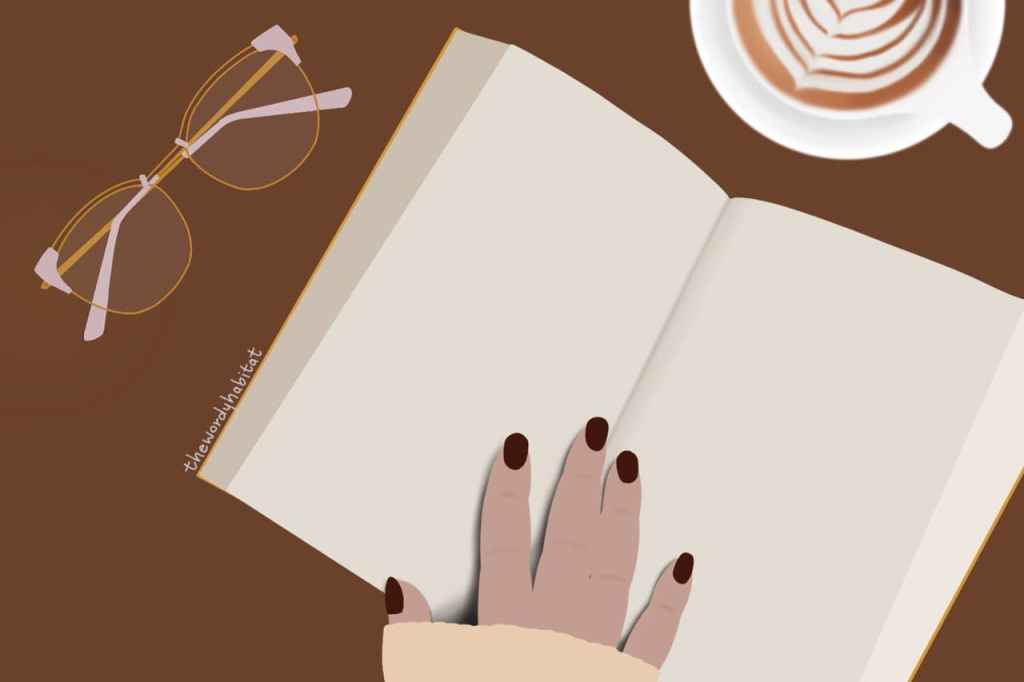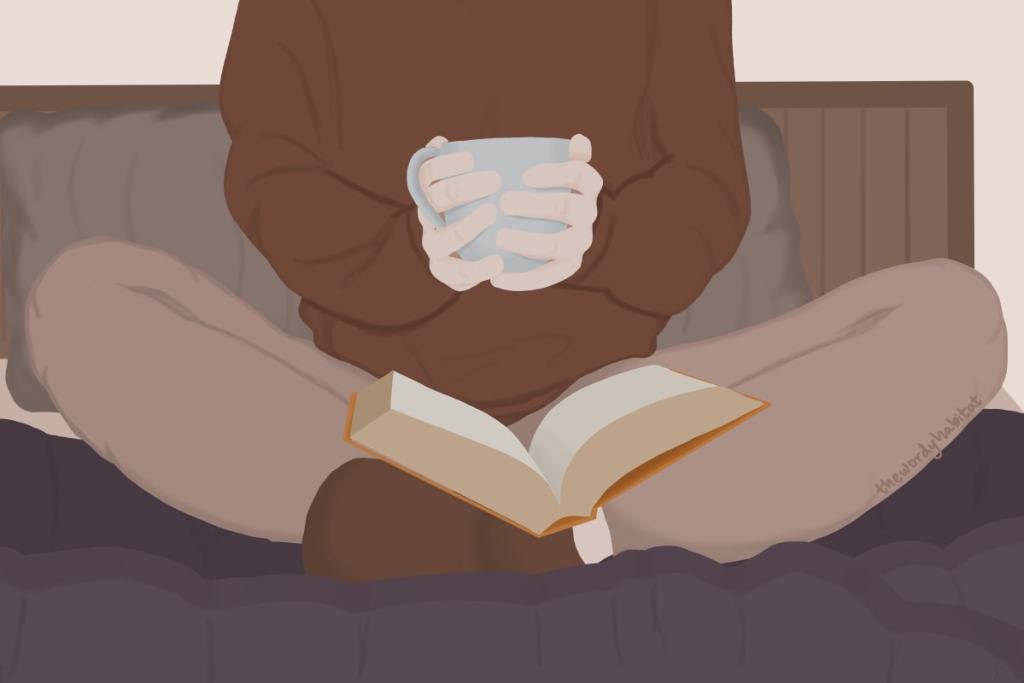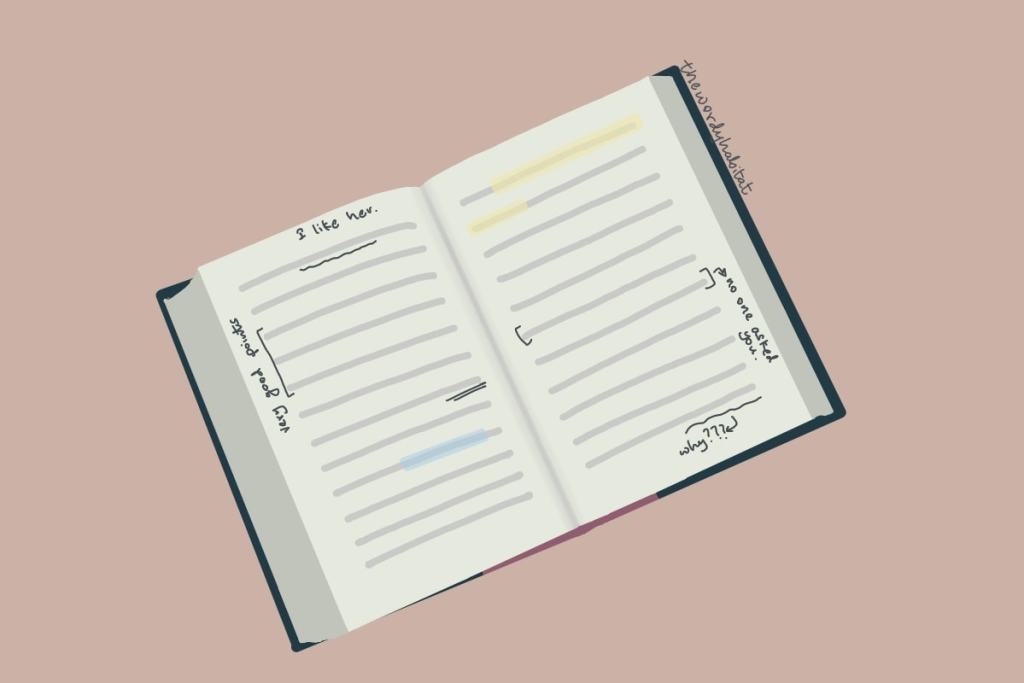Congrats, you’re already one step there by reading this post.
The main requirement to do something is wanting to do it. It will push you to work on it and find ways to do it. To develop a reading habit, you must want to create one first.
Reading is like anything else. If you want to do more of it, you have to build it into your routine and read as a habit. Whether your last book was good or not, whether you have movies on your watch list or not, whether it serves an exact purpose or not—you should be compelled to pick up a book.
Building a reading habit, like any other habit, doesn’t happen overnight or even in a week. It takes a while and it takes different types of effort. But let me assure you of one thing: this post is all you need to start building a reading habit. Whether you’re a new reader or a returning reader, this post will help you.
I believe that James Clear’s advice in Atomic Habits is great to build any habit and his cardinal rules of behavioural change apply to reading as well. In this post, I will be sharing actionable steps that will help you develop a reading habit and categorize them using Clear’s rules so that you know why, when, and how you should apply them.
make reading obvious
Contents
The main problem we face while trying to develop a habit is remembering to do the habit. In the beginning, there needs to be a conscious effort to choose to do this action instead of whatever other action you generally do. That effort is harder when you also need to remember that you’re trying to build a reading habit.
Here are a few ways you can make reading obvious so that you won’t have to remember it.
1. surround yourself with readers
If you have friends who read, talk to them more often, especially about the books that they read. If not, try to make new friends who read. Follow readers online such as on Instagram or Twitter. Read book blogs (like mine!).
When you look at people reading, you will want to read too. We are highly influenced by the people that surround us. One way to change what you do is to surround yourself with the people you want to be like. To develop a reading habit, frequently interact with people who have reading habits.
The best part about the internet is the ease with which you can connect with people. The online book community is huge and it is easy to find other readers with similar tastes as yours.
2. keep a book on your table or next to your bed
Although I have a reading habit, I mostly read ebooks. I don’t read enough paperbacks and I recently vowed that I will read more from my physical shelf. I started keeping my current read on my table and it actually helped me read the book more. Whenever I’m bored or have a bit of time, the book is almost in front of me so I pick it up and read a bit.
Our physical environment influences our habits in ways we can’t fully understand. But from the little we know, we can use it to change our habits.
Figure out one spot in your environment which you often look at. It could your table or your nightstand, or the couch in your living room. Keep a book in that spot so that you often see it. It will increase the chances of you picking it up.

3. set aside some time to read every day
Creating a plan is powerful. When you write down or share that you are going to do something every day at a certain time, you are compelled to follow it. You might not always do it, but it’ll be in the back of your mind when the time comes around.
When I need to form a habit at a certain time, I set recurring reminders on my phone to remind me to do it every day at that time. In the initial days, it is very helpful because it reminds me that I need do that action.
You can set reminders, create calendar events, or even commit with someone you know so that they will remind you. After a while, you will not need the reminders anymore and will read on your own.
The best times to read are generally right after waking up or right before going to bed because you’re not between two tasks. You can also decide to read during your tea breaks or after you return home from school/work. Find a little downtime in your day and dedicate it to reading.
make reading attractive
“The secret to making reading a habit is to make it effortless and enjoyable.” – Tiago Forte
When something is attractive and enjoyable, we want to do it more. It is human nature. Most people find reading to be dreary so they find it hard to develop a reading habit. To develop a reading habit, you have to find reading attractive. If you don’t find it attractive yet, here are some ways to shift your perspective so that it helps.
4. create a good to-read list
Having a list of interesting books to read will push you to try reading one of them. A “good to-read list” contains books about your interests and stories that sound exciting to you. Don’t only try books that are popular because sometimes the popular books are not beginner-friendly. Ask your reader friends for suggestions and google books for new readers. Whenever someone raves about a book, add it to your list. If an interesting book is mentioned in your current book, add it. Build your list as you go.
The next time you need to start a new book, you will have a small list to choose from. You won’t have to deep dive into the internet and get overwhelmed with the choices. You don’t have to wade through recommendations for a book that sounds good. Having a list makes picking your next read easier.
5. find books like the ones you liked
When you finish a book that you enjoyed, search for books like it! You can search with the title and author or with other factors. Did you like that the main character was a lost royal? There are several books with that. Did you like the queer romance? Here’s a queer book list. Did you like that the book was written in epistolary format? There are more books for you! Do you like romance? Try more books from the genre.
No matter how odd or unique the tropes sound, you will find more books with them. Trust me, there are always people on the internet with the same interests as yours and it is very likely that one of them would have compiled a list of recommendations.
The best way to cultivate a reading habit is to enjoy books for which you have to find more books based on what you have already liked. Find them and add them to your to-read list.

6. join a book club
Book clubs make reading very fun because you’re reading and discussing with a group of people. There are different types of book clubs as well—celebrity book clubs, small book clubs on Instagram, and more. Some book clubs read only certain types of books while others choose random ones. There are book clubs where people meet (in life/virtually) and read in silence for a while. I recently joined a friend’s book club where the audiobook is streamed centrally for an hour every week and we discuss it afterwards.
If you start looking, you are bound to find a bunch of book clubs. Join one and try it. If it doesn’t suit you, try another book club. Try a bunch of them and find your book club.
7. get a buddy to read with
If book clubs aren’t for you, try buddy reading! It’s more intimate to buddy read with someone and you’re bound to have more conversation. You can decide on reading a set amount every day/week or you can simply read whenever you’re free and discuss when the other person has caught up. Having someone else read a book with you can highly motivate you.
Not every person will be great to buddy-read with because both your reading and discussion styles have to match. I suggest trying to buddy read with multiple people over time so that you get used to it and find someone whose style and reading tastes match yours.
8. participate in or start a reading challenge
There are several types of reading challenges out there. There are reading challenges with generic prompts, challenges themed about something like Animal Crossing or mythologies, and ones that run for a specific amount of time with no other rules.
Hosts of reading challenges often host reading sprints (a short time period for everyone to read with no distractions and share their updates when done) and create bingo cards or point-based systems as well.
If you don’t want to start with others or join one, you can create your own challenge and share updates wherever.
Reading challenges can be very fun because of how creative they are and because it’s a goal that you can easily work towards. Completing a reading challenge is highly satisfying too. Find some interesting reading challenges and try them!
make reading easy
No matter how obvious or attractive something is, you won’t do it consistently if it is not easy. Humans follow the Law of Least Effort—picking the option that requires the least amount of work between the given options.
But one of the key points to building a reading habit is repetition. It’s the frequency that makes a difference. In order to do it again and again, you have to make reading easy for yourself.
9. always have a book with you
If you have a book with you at all times, you are more likely to use unexpected opportunities in your day to read. For example, during a commute or while waiting for an appointment.
My phone has the Kindle and Libro.fm apps which means that I’m always carrying two formats of books with me. I generally use them during travel or on vacations.
Make it easy to read whenever you want to. The worst thing is to want to read but not have a book on hand. Use apps like Kindle and Libro.fm and move them to your phone’s home screen.
Reading doesn’t always have to be done at home. Take your books out! Take them to coffee shops and parks and read there. Listen to audiobooks on walks. Take your Kindle if you’re going out for errands.

10. read for a short period every day
This is a great way to form habits, especially for beginners. Instead of setting goals as chapters or books, set time as a goal.
Read for, let’s say, 10 minutes every day and the time of the day doesn’t matter. It’s fine if you stop in the middle of a chapter. You can also set a timer and make sure that you only read for that much time with full concentration. Or if you are engrossed in the book after 10 minutes, you can continue.
Slowly, you will begin to read more and will read for 10 minutes every day without a reminder. It may seem small but 10 minutes a day is easy and adds up over time. It is a starting point.
11. find your format
Reading books has become easier nowadays because of the formats available. A few decades back, we had only regular physical copies but we have ebooks and audiobooks now. They have opened up the ways in which you can read, so use them.
Try out the different formats at different times of day and see what fits into your routine. If you’re always moving and working with your hands, audiobooks might be better for you. If you want to carry books with you but don’t like the weight, use a Kindle device. After a few tries, you will figure out a place and/or time where they will fit in seamlessly.
As your lifestyle or routines change, your format might change as well. If things aren’t working anymore, go back to experimenting and I’m sure you’ll find a new way where reading is easy.
12. give books a trial period
Don’t commit to reading entire books before determining if you’ll enjoy them. Reading all of a book that you don’t like is hard and we don’t want that.
Read 5-10% of books and then decide if you want to continue them. If you’re hating it or are unable to connect with it, drop it and pick another book. Don’t see that amount of reading as “sunk costs.” Instead, see them as an investment in trying books and finding your tastes. It is better to discard 10 books to find one that will make you want to read 10 more books.
You can give books trial periods by reading bits of them in bookstores or by reading samples on Goodreads. If you’re able to borrow from the library, use it. If your friends own books, borrow from them.
13. drop books at any time if you don’t like them
As I said before, reading books that you don’t like is hard. It is entirely possible that you will begin to hate a book after you finish half of it. Don’t worry about sunk costs—the time and effort you spent on the book—and think of the time you would save by putting the book down.
Use your time to read books that you like. If you significantly dislike a book, stop reading them at any time and pick up another book.
You can’t avoid books that you won’t like, it is not possible to pick only “good” books every time. We all end up reading books that we hate sometimes. The important part is not letting those books stop you from reading more. Once you associate reading with something you don’t like, you will find it harder to continue reading any book.

14. try reading multiple books at a time
After years of reading, I know my reading tastes. I like romance books, can get through fantasy, and struggle with non-fiction and literary fiction. I want to read in the latter genres but I cannot read them as easily as romance. In order to balance things, I read a romance book and a non-fiction book at the same time.
Whenever I’m finding non-fiction dreary or boring, I switch to a romance book to keep my reading going and return later. Sometimes, I read books in different formats at the same time. Currently, I have one book going in each of the reading formats. If I’m bored with one, I switch to another.
Make reading easy for you by giving yourself options. This especially helps if you’re a mood reader and might want to read literary fiction in the morning and fantasy at night. Or you can read a novel and a comic at the same time. When you do not like one book, switch to the other. Read different or the same book in multiple formats.
If the above way overwhelms you, discontinue it. It could work really well for some and might be bad for others. Try it out and decide for yourself.
15. find or create your reading space
Having a comfortable space to read can make all the difference. You will associate it with reading and it will always be ready with whatever you need like blankets or a table next to it for drinks. Finding or setting up a place to read right when you want to read can put you off.
I have a two-seater couch at home which is where I do most of my reading. I got a wedge pillow to sit sideways and curl up. I have the bed nearby if I want to keep my laptop on it for music or anything else. Because it is easy to sit and dive into the book directly, I don’t hesitate to pick up a book.
Try different places at home and do different things with them. Get a drink, get blankets, or put on mood music like LoFi. Try leaving your phone in a different room.
make reading satisfying
Even if something is easy to do, you won’t consistently do it for a long time if it is not satisfying. When an action is satisfying, your brain basically goes “do it again” which leads to habit formation. You will develop a reading habit only if you also find reading satisfying. You need to make reading fun.
16. maintain a reading tracker
Trackers require less effort but provide a lot of satisfaction. The simple act of checking or crossing off dates is satisfying. Looking at a row of crossed-off dates will motivate you to keep doing the habit in order to maintain your streak too. Even if reading the book takes several days, looking at the tracker will give you a sense of progress and will push you to read again.
Challenge yourself to read a bit every day and update your tracker when you’re done at the end of each day. You can use a simple wall or desk calendar or use printables from the internet (I’ve provided a habit tracker template in my resource library too!). There are several apps for habit tracking as well.
17. annotate your reads
Annotating makes reading 10 times more fun. Annotating is basically engaging with the book, writing down your thoughts, and marking the good stuff. Seeing an annotated copy after you’re done reading is satisfying like nothing else.
Grab some sticky tabs and a pen. Write your thoughts in the margins—even if they’re only “OMG” and “!!!”—and tab your favourite lines or parts. You will enjoy the book far more once you start annotating. For more help and info, here’s an entire guide on annotating books.

18. create your bookish accounts
Nothing is more satisfying than sharing your progress and thoughts with other people. It is the same for reading as well. While reading or after you’re done, you will want to share your thoughts. Often, we don’t have people ready to listen to us go off about books. That’s where the online book community helps.
Choose your favourite platform and create a bookish account. Share your reads, thoughts, and reviews there. Engage with others. This is the final step in your indoctrination into the bookish person you’re meant to be.
Pretty soon, having a bookish account will motivate you to read more. It also helps with finding recommendations, finding book clubs and buddies to read with, and sharing progress. Honestly, having a bookish account can greatly help you develop a reading habit.
bonus tip
I have one very important tip that doesn’t fit well in any of the above categories. But it is one that has worked wonders for my reading and will help you as well.
19. don’t end with the end of a book
After you finish reading a book (whether you’ve read the last line or are dropping a book mid-way), read a page of a new book before you stop reading for the day.
A huge problem that all readers face is picking up a new book after the current read is done. You may finish reading a book but you have to keep the reading going. Some people simply put off picking the next book and others struggle to choose their next book. I get it, it’s hard to choose out of the many options you have even with your to-read list.
That’s where this practice comes in. After you’re done with a book, choose your next book in 5 minutes and read a bit of it. You can read one page or one chapter—read enough to be able to say that you’re currently reading that book. And then, place it on your desk or nightstand.
I put this into practice because I wanted to read more paperbacks and I have read so many paperbacks since then. I used to struggle to read one paperback a month but I’ve finished 4 in the last month.
It is easier to pick up a book you’re currently reading than start a new one. So make sure you don’t let yourself spend too much time picking a new one.
endnotes
A habit doesn’t form in a few days and it also doesn’t form with only one thing. It starts with one but to embed a reading habit in your routine, you need to do more than one thing. That’s something that none of the other posts about reading tells you.
If you see any reader, they habitually do multiple things. Take me for example—I surround myself with readers, have a TBR, read multiple books at a time, and annotate my reads. Similarly, to develop a reading habit, you will need to adopt one aspect from every section above.
You don’t need to take multiple things at once. Pick one and add it to your routine. Once that is done, pick another, and so on.
Here’s an easy combination to start with:
- Keep a book at obvious places in your home.
- Join a book club.
- Read for a short period every day.
- Maintain a reading tracker.
You will have a reading habit when you find reading obvious, attractive, easy, AND satisfying.
